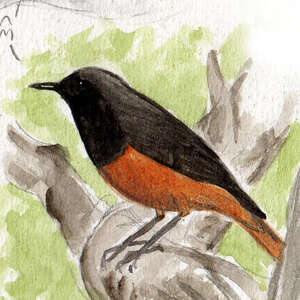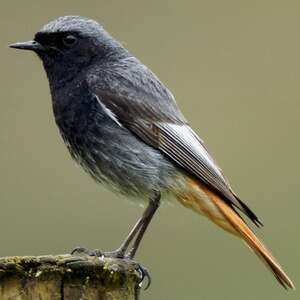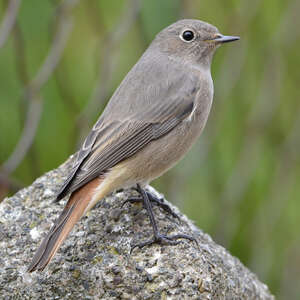Black Redstart
Phoenicurus ochruros - Rougequeue noir
Identification
The Black Redstart is a small and discreetly coloured bird, frequently found in a human environment, but not exclusively. Across their very wide range, stretching from Western Europe to Eastern China, the species includes five subspecies that are easily distinguishable, at least in the males.
The adult male in the west European subspecies gibraltariensis, which inhabits France, appears completely black from a distance. On closer inspection however, you can see that its upperparts are a slate-grey colour, contrasting sharply on the wings with a whitish area formed by the outer edges of the secondaries. The front of its body is black - forehead, lores, cheeks, throat, and breast - to a greater or lesser degree, depending on the individual. Its dark eye does not stand out much against this black background. Usually, it has an element of whiteness at the rear of its forehead. Its belly has a gradient of grey, from front to back. The whole back of its body, its rump and upper-tail coverts, as well as its lower belly and under-tail coverts, is an intense orange. Its tail is a dark grey-brown colour near its central rectrices, while its outer rectrices are orange, a characteristic element that is very visible when it takes flight. Its beak and feet are black.
The male obtains the fully adult plumage only when it is two years old. An individual of one year old, in contrast, is grayer, less black, and often lacks the clear area on the wing. Despite this, it is able to reproduce.
The female is a greyish-brown with brown tinges on its cheeks and its wings are darker, lacking the white area. Its underside is a greyish-beige, sometimes tinged with fawn. The tail is the same as that of the male. Its under-tail coverts are a pale orange.The juvenile resembles the female, but it is darker above and below. At first, the yellow lores indicate its young age.
Subspecies differ in the importance of the orange colour of the lower parts of the male. There is a clinal variation between the western subspecies gibraltariensis in which only the abdomen and undertail coverts are orange, and the easternmost rufiventris in which the entire belly and lower chest are orange, which is confusing for a European. The same variation applies to the colour of the mantle and the coverts which change from dark grey in the west to black in the east. On the other hand, the pale wing patch tends to diminish from west to east, disappearing in rufiventris. The male of the Asian subspecies phoenicuroides is disturbing, as its name implies. Without a pale wing patch and showing a pale patch behind the black forehead, it resembles the male of the Black Redstart or a hybrid ochruros x phoenicurus.
Subspecific information 6 subspecies
- Phoenicurus ochruros ochruros (Turkey to the Caucasus and nw Iran)
- Phoenicurus ochruros gibraltariensis (Europe and nw Africa)
- Phoenicurus ochruros semirufus (w Syria, Lebanon and ne Israel)
- Phoenicurus ochruros phoenicuroides (ne Iran and Turkmenistan to nw Pakistan north to se Kazakhstan, nw China, sc Siberia and w Mongolia)
- Phoenicurus ochruros murinus ()
- Phoenicurus ochruros rufiventris (Central Himalayas to c China)
Foreign names
- Rougequeue noir,
- Colirrojo tizón,
- rabirruivo-preto,
- Hausrotschwanz,
- házi rozsdafarkú,
- Zwarte Roodstaart,
- Codirosso spazzacamino,
- svart rödstjärt,
- Svartrødstjert,
- žltochvost domový,
- rehek domácí,
- Husrødstjert,
- mustaleppälintu,
- cotxa fumada,
- Húsaskotta,
- kopciuszek (zwyczajny),
- melnais erickiņš,
- šmarnica,
- Горихвостка-чернушка,
- クロジョウビタキ,
- 赭红尾鸲,
- นกเขนสีดำ,
- 赭紅尾鴝,
Voice song and call
The song is a rather short phrase which starts with a held grating sound that reminds of the noise of crumpled paper and continues with the rapid repetition of a note tu tu tu tu tu that reminds of the Black Redstart.
Two common calls can be noted which both express the adults' fear of danger. Firstly, a rather sharp and often repeated sit, the repetition frequency of which indicates the level of fear. The second is a tec also willingly repeated in series of 3 or 4 notes. These calls can last for long minutes until the danger goes away.
The juvenile's call is a sharp two syllabic tsi kr. It is a begging call for food. It helps the parents locate their youngers for a better food supply.
Habitat
The Black Redstart is very linked to rocky habitats, both natural (cliffs, rocky talus, stony slopes, gorges, etc.
It appreciates clear areas of all sorts as foraging grounds, from mountainous slopes to agricultural zones, maritime shores and urban environments, among others. Once tree cover reaches 25%, however, it disappears in favour of its congener, the White-fronted Redstart, who takes its place. Its adaptation to the urban environment allowed it to extend its range to the lowlands.
Behaviour character trait
The Black Redstart is a fairly fearless bird. It's identified by its cries and its singing when it perches out in the open, not trying to hide. Its singing adds to the soundscape of rural villages in the spring. In an urban environment, this sound can pierce through the noise of the city.
The bird is most often spotted perched on an exposed support (post, wire, bush, low branch of a tree) from where it surveys the ground nearby to spot its prey which it dives toward in a direct flight. On the ground, it moves around by hopping. At all times, it nervously fans its tail vertically in a curious mechanical motion.
It is not gregarious, but during migration, small groups, usually no more than 10 individuals, can be seen in favourable places. In breeding season, the largest groups are the family groups.
The Black Redstart is monogamous and territorial. When habitat is optimal, territories can be contiguous. Intruders are chased off strenuously by holders with loud cries.
Always perched out in the open, either on a rock or at the peak of a roof, the male sings his song like a challenge to his congeners. He thus asserts his territory which he will defend throughout the warm season. He sings even before the sunrise, and then all throughout the day at the start of the breeding period, before his role of doting father fully takes up his time. After the young fledglings take flight, it is their chirpy cries calling out for their food which draws the attention of the adults, as well as ours.
Flight
The Black Redstart has an easy and direct flight, with regular wing beats typical of the Muscicapidae family. It is in a mountainous environment where it best expresses its abilities when, in one sweep of its wings, it reaches the top of a cliff. It knows how to hover, for example when it comes to grabbing an insect on a rocky wall or a wall.
Dietfeeding habits
The Black Redstart is primarily an insectivore, feeding on various terrestrial invertebrates, mainly insects and/or their larvae, but also spiders, centipedes, small mollusks, small earthworms, etc.
In coastal areas, it can consume small intertidal crustaceans. It also feeds on small fruits and berries when the season provides. Seeds are marginal in its diet.It needs clear, little vegetated spaces to hunt. It spots its prey from a dominant lookout post and usually captures it on the ground. It can also look for them fluttering from one stone or clod to another. It also knows how to capture insects resting on a rocky wall or a wall, less commonly flying insects. The small fruits are picked in place and not collected from the ground.
Reproduction nesting
The nesting of the Black Redstart is semi-cavernous. It looks for all sorts of crevices, more or less open, generally protected by an overhang that confines it, and this in a rocky environment.
On a building, the nest will often be built under the roof, at the top of the wall or on a structural element, provided it is accessible. In the mountains, a crevice in a crack or a space eroded between two geological strata will host the nest.The nest, built by the female, is a fairly loose and unstructured assembly of dry plant material (grass, straw, leaves, moss). The cup is lined with fur and feathers that make it cozy. The female lays 4 to 6 shiny white eggs in it, which she will brood alone for about 13 days. The young are fed in the nest for a 15-day period, then for another 15 days to 3 weeks after taking flight. Often, the family splits into two at this time, the male and female each taking charge of part of the siblings. A second brood can quickly follow once the female is released from her role as a wet nurse.
Geographic range
The Black Redstart is a Eurasian species whose range extends from the Atlantic to the east of China, mainly at medium latitudes. This area can be broken down into two sets, the western covering Europe (ssp gibraltariensis) and Asia Minor (ssp ochrozros), the eastern and Asian (ssp phoenicuroides and rufiventris) to which is added a small Middle Eastern population (ssp semirufus).
Scandinavia and Russia are only marginally occupied in the south, proof that the species has no boreal affinity. The species is not common in the United Kingdom.
To the south of its range, the Black Redstart looks for altitude to escape too hot a climate. This is how it is found in Moroccan atlases, the mountains of northern Algeria, those of Iran, and farther east, the mountains of Central Asia, then the Pamir and Himalayas.
In winter, the birds in the higher latitudes move south and, for example, reach the Mediterranean coast to the west. To the east, the migrants spread out across the Indian subcontinent, the Arabian peninsula and northeastern Africa. These are true migrants. The southern mountain birds simply migrate by altitude.
Threats - protection
Sources of information
- IOC World Bird List (v15.1), Gill, F and D Donsker (Eds). 2025-12-07.
- Avibase, Lepage Denis
- HBW Alive,
- xeno-canto, Sharing bird sounds from around the world,
- Les passereaux d'Europe, tome 1, P. Géroudet, M. Cuisin
Other sources of interest
 Specification sheet created on
04/07/2023 by Jean François
Specification sheet created on
04/07/2023 by Jean FrançoisTranslation by AI Oiseaux.net
© 1996-2026 Oiseaux.net
- Accipitriformes
- Aegotheliformes
- Anseriformes
- Apodiformes
- Apterygiformes
- Bucerotiformes
- Caprimulgiformes
- Cariamiformes
- Casuariiformes
- Charadriiformes
- Ciconiiformes
- Coliiformes
- Columbiformes
- Coraciiformes
- Cuculiformes
- Eurypygiformes
- Falconiformes
- Galliformes
- Gaviiformes
- Gruiformes
- Leptosomiformes
- Mesitornithiformes
- Musophagiformes
- Nyctibiiformes
- Opisthocomiformes
- Otidiformes
- Passeriformes
- Pelecaniformes
- Phaethontiformes
- Phoenicopteriformes
- Piciformes
- Podargiformes
- Podicipediformes
- Procellariiformes
- Psittaciformes
- Pterocliformes
- Rheiformes
- Sphenisciformes
- Steatornithiformes
- Strigiformes
- Struthioniformes
- Suliformes
- Tinamiformes
- Trogoniformes


































